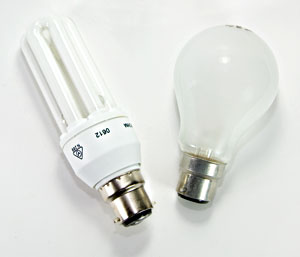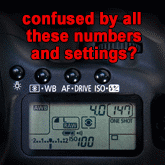With Australians being forced to switch from incandescent globes to
compact fluorescent lamps (CFL), it's important to be aware of the fact that
CFLs contain mercury.
Breaking a CFL will release this mercury, and there are some significant
health and safety issues associated with cleaning up this mercury,
as well as disposing of CFLs.
On February 2007, the Australian Federal Government announced that
incandescent light bulbs would be banned in Australia by the year 2010.
Apparently that makes Australia the first country in the world to announce such a ban
(
ref 1,
ref 2).
The primary reason for this ban is to encourage the use of compact fluorescent lamps
instead of incandescent globes, as CFLs use approximately 80% less electricity,
thus reducing Australia's greenhouse gas emissions.
Apparently by 2015, the switch to CFLs will reduce our greenhouse gas emissions by up to
four million tonnes per year.
While I support this reasoning, I have a number of concerns about being forced to switch to CFLs:
- CFLs are more expensive than incandescent globes
- most CFLs are not compatible with most dimmers
- some light fittings cannot accommodate CFLs
- CFLs can cause RF interference and noise
- CFLs have a slower turn-on time
- it requires more energy to make a CFL than an incandescent globe
I've been using some 30W CFLs (150W equivalent) for my photographic light tent, and find them
better than incandescent globes for multiple reasons, including the fact that they generate much
less heat, they provide a more distributed lighting, and they provide a better colour temperature.
However, an MSNBC article titled
Shining a light on hazards of fluorescent bulbs
alerted me to the possible safety and health issues associated with compact fluorescent lamps.
The mercury content in the CFLs is
hazardous
to humans, and can be inhaled, and absorbed through the skin,
and can cause both chronic and acute
poisoning.
The US EPA provides a webpage that describes
what to do if a fluorescent light bulb breaks,
and it's a lot more complex than just sweeping up and vacuuming the broken glass off the floor!
Note that the EPA guidelines were recently updated based on the results of a detailed study
by the Maine Department of Environmental Protection, titled
Maine Compact Fluorescent Lamp Breakage Study Report.
They found that
Cleaning up a broken CFL by vacuuming up the smaller debris particles in an un-vented room can elevate mercury
concentrations over the MAAG in the room and it can linger at these levels for hours.
Vacuuming tends to mix the air within the room such that the one foot and five foot heights are
similar immediately after vacuuming. A vacuum can become contaminated by mercury such that it
cannot be easily decontaminated. Vacuuming a carpet where a lamp has broken and been visibly cleaned up,
even weeks after the cleanup, can elevate the mercury readings over the MAAG in an un-vented room.
In addition to the mercury vapour being vented into the air, they said that mercury on the floor or in the carpet has
particular significance for children rolling around on a floor, babies crawling, or non mobile infants placed on the floor.
The Australian Government has also published
guidelines
(scroll down to "question 3") similar to those on the US EPA website for cleaning up a broken CFL,
although the procedure is not as detailed or thorough as the US version:
While ordinary incandescent lamps can be disposed of with the usual household rubbish, CFLs, fluorescent tubes and some other high intensity lamps may present a health hazard if not handled correctly when broken, as they contain mercury. Although the mercury content of CFLs is small, lighting companies typically recommend that if a CFL breaks, people should:
- Open nearby windows and allow the room to ventilate for 15 minutes before cleaning up the broken lamp;
- Do not vacuum the broken lamp as this can contaminate the appliance with mercury and spread the mercury through the air;
- Use disposable rubber gloves rather than bare hands;
- Use a disposable brush to very gently sweep up the pieces - making sure you don't scatter them more widely;
- Use a moist paper towel to wipe up any remaining small fragments;
- Wrap lamp remains in newspaper to ensure the glass cannot pierce a plastic bag and place in a bag or sealable container along with the cleaning equipment used (i.e. gloves, brush, damp paper); and
- Place in your outside rubbish bin.
I wonder how many people are using CFLs in their house, and are not aware of the issues associated with
cleaning up a broken CFL. I'm sure there have been countless instances where a CFL has been
accidentally broken, and the residents have just vacuumed up the broken glass in an un-vented room,
thus spreading mercury throughout the room.
The Australian Government's
Dept of Environment, Water, Heritage and the Arts website
indicates that the Government is developing standards for mercury content in CFLs.
They also have a web page dedicated to
safe disposal of mercury containing lamps,
which states
Australian governments are examining the need for a national recycling scheme for compact fluorescent lamps (CFLs) and other fluorescent lamps. The advice below, regarding the safe and responsible disposal of these lamps, has been prepared as an interim measure.
In other words, the Aussie Government bans incandescent globes to force the use of CFLs,
but more than 12 months after announcing the ban, still hasn't put in place a recycling scheme for CFLs,
but only have interim recommendations.
Apparently
there is no collection service for CFLs available in Western Australia,
although there was
one recycling company
that was accepting a maximum of two drop offs (6 lamps or less)
per household from July 2007 until the end of January 2008.
Similarly, many other Australian states do not have a collection service for CFLs,
or only have a limited collection service, or a minimal number of drop-off points for CFLs.
According to
Wikipedia,
only 3% of CFL bulbs are properly disposed of or recycled.
One last quote from the
Government's website:
If recycling is not an option, check whether your local household chemical waste depot accepts fluorescent lamps. If there is no other option, wrap used lamps in newspaper to prevent them from breaking and place them in your rubbish bin. This is not the preferred method of disposal.
Until the Government sorts out a recycling scheme, it looks like we'll have to keep contributing
mercury-containing CFLs to landfill, even though the Government admits that
this is not the preferred option.




It's true we are not doing enough to recycle CFL's (Ikea collects them though I think), but even without recycling them, they produce less mercury than incandescents powered by coal (here in Australia).
There are many charts on the net: http://www.healthgoods.com/Shopping/images/CFL_Incandescent_Mercury_Production.gif
Also, as manufacturers like Philips start producing more low mercury lamps, the health aspect will become less of an issue:
http://www.treehugger.com/files/2007/02/low_mercury_flu.php